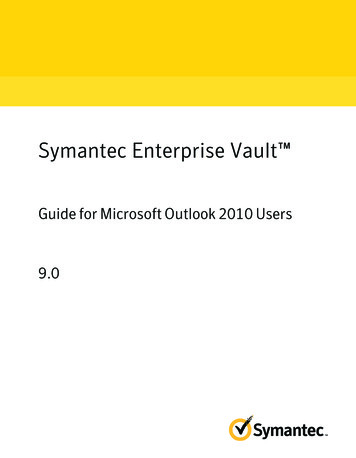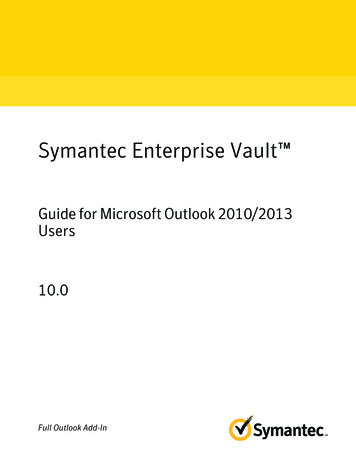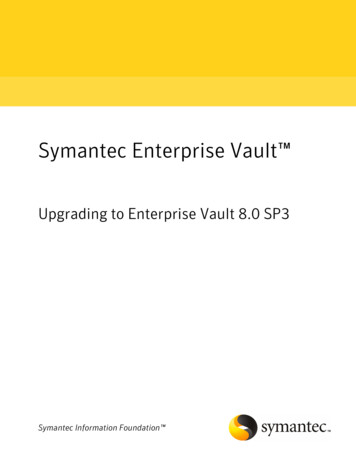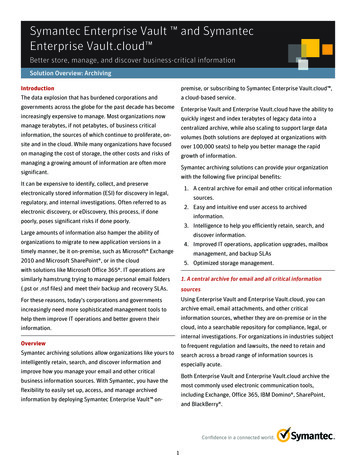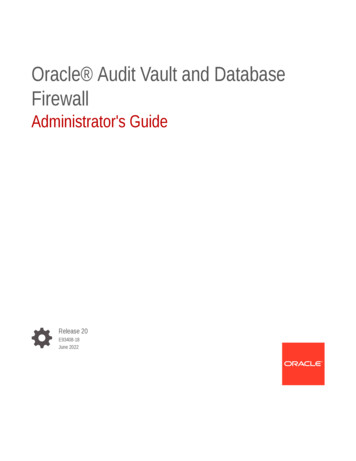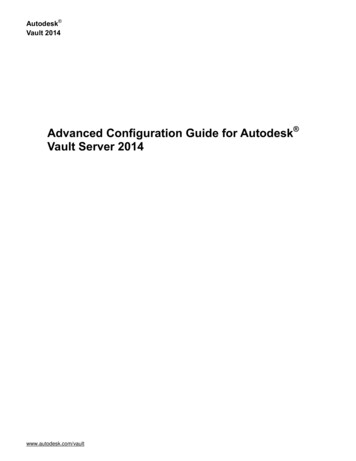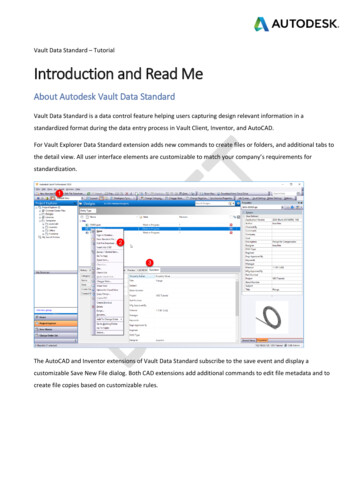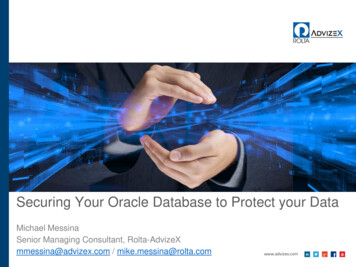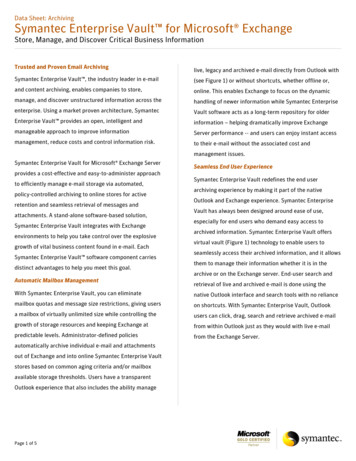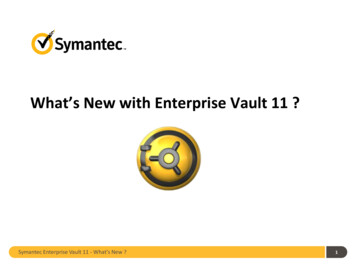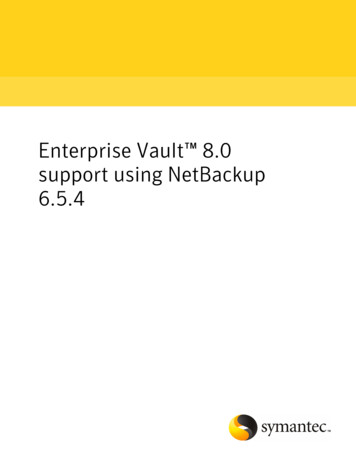
Transcription
Enterprise Vault 8.0support using NetBackup6.5.4
The software described in this book is furnished under a license agreement and may be usedonly in accordance with the terms of the agreement.Documentation versionPN:Legal NoticeCopyright 2009 Symantec Corporation. All rights reserved.Symantec, the Symantec Logo are trademarks or registered trademarks of SymantecCorporation or its affiliates in the U.S. and other countries. Other names may be trademarksof their respective owners.This Symantec product may contain third party software for which Symantec is requiredto provide attribution to the third party (“Third Party Programs”). Some of the Third PartyPrograms are available under open source or free software licenses. The License Agreementaccompanying the Software does not alter any rights or obligations you may have underthose open source or free software licenses. Please see the Third Party Legal Notice Appendixto this Documentation or TPIP ReadMe File accompanying this Symantec product for moreinformation on the Third Party Programs.The product described in this document is distributed under licenses restricting its use,copying, distribution, and decompilation/reverse engineering. No part of this documentmay be reproduced in any form by any means without prior written authorization ofSymantec Corporation and its licensors, if any.THE DOCUMENTATION IS PROVIDED "AS IS" AND ALL EXPRESS OR IMPLIED CONDITIONS,REPRESENTATIONS AND WARRANTIES, INCLUDING ANY IMPLIED WARRANTY OFMERCHANTABILITY, FITNESS FOR A PARTICULAR PURPOSE OR NON-INFRINGEMENT,ARE DISCLAIMED, EXCEPT TO THE EXTENT THAT SUCH DISCLAIMERS ARE HELD TOBE LEGALLY INVALID. SYMANTEC CORPORATION SHALL NOT BE LIABLE FOR INCIDENTALOR CONSEQUENTIAL DAMAGES IN CONNECTION WITH THE FURNISHING,PERFORMANCE, OR USE OF THIS DOCUMENTATION. THE INFORMATION CONTAINEDIN THIS DOCUMENTATION IS SUBJECT TO CHANGE WITHOUT NOTICE.The Licensed Software and Documentation are deemed to be commercial computer softwareas defined in FAR 12.212 and subject to restricted rights as defined in FAR Section 52.227-19"Commercial Computer Software - Restricted Rights" and DFARS 227.7202, "Rights inCommercial Computer Software or Commercial Computer Software Documentation", asapplicable, and any successor regulations. Any use, modification, reproduction release,performance, display or disclosure of the Licensed Software and Documentation by the U.S.Government shall be solely in accordance with the terms of this Agreement.
Symantec Corporation350 Ellis StreetMountain View, CA 94043http://www.symantec.comPrinted in the United States of America.10 9 8 7 6 5 4 3 2 1
Technical SupportSymantec Technical Support maintains support centers globally. TechnicalSupport’s primary role is to respond to specific queries about product featuresand functionality. The Technical Support group also creates content for our onlineKnowledge Base. The Technical Support group works collaboratively with theother functional areas within Symantec to answer your questions in a timelyfashion. For example, the Technical Support group works with Product Engineeringand Symantec Security Response to provide alerting services and virus definitionupdates.Symantec’s maintenance offerings include the following: A range of support options that give you the flexibility to select the rightamount of service for any size organization Telephone and Web-based support that provides rapid response andup-to-the-minute information Upgrade assurance that delivers automatic software upgrade protection Global support that is available 24 hours a day, 7 days a week Advanced features, including Account Management ServicesFor information about Symantec’s Maintenance Programs, you can visit our Website at the following URL:www.symantec.com/techsupp/Contacting Technical SupportCustomers with a current maintenance agreement may access Technical Supportinformation at the following URL:www.symantec.com/techsupp/Before contacting Technical Support, make sure you have satisfied the systemrequirements that are listed in your product documentation. Also, you should beat the computer on which the problem occurred, in case it is necessary to replicatethe problem.When you contact Technical Support, please have the following informationavailable: Product release level Hardware information Available memory, disk space, and NIC information Operating system
Version and patch level Network topology Router, gateway, and IP address information Problem description: Error messages and log files Troubleshooting that was performed before contacting Symantec Recent software configuration changes and network changesLicensing and registrationIf your Symantec product requires registration or a license key, access our technicalsupport Web page at the following URL:www.symantec.com/techsupp/Customer serviceCustomer service information is available at the following URL:www.symantec.com/techsupp/Customer Service is available to assist with the following types of issues: Questions regarding product licensing or serialization Product registration updates, such as address or name changes General product information (features, language availability, local dealers) Latest information about product updates and upgrades Information about upgrade assurance and maintenance contracts Information about the Symantec Buying Programs Advice about Symantec's technical support options Nontechnical presales questions Issues that are related to CD-ROMs or manuals
Maintenance agreement resourcesIf you want to contact Symantec regarding an existing maintenance agreement,please contact the maintenance agreement administration team for your regionas follows:Asia-Pacific and Japancustomercare apac@symantec.comEurope, Middle-East, and Africasemea@symantec.comNorth America and Latin Americasupportsolutions@symantec.comAdditional enterprise servicesSymantec offers a comprehensive set of services that allow you to maximize yourinvestment in Symantec products and to develop your knowledge, expertise, andglobal insight, which enable you to manage your business risks proactively.Enterprise services that are available include the following:Symantec Early Warning Solutions These solutions provide early warning of cyber attacks, comprehensive threatanalysis, and countermeasures to prevent attacks before they occur.Managed Security ServicesThese services remove the burden of managing and monitoring security devicesand events, ensuring rapid response to real threats.Consulting ServicesSymantec Consulting Services provide on-site technical expertise fromSymantec and its trusted partners. Symantec Consulting Services offer a varietyof prepackaged and customizable options that include assessment, design,implementation, monitoring, and management capabilities. Each is focused onestablishing and maintaining the integrity and availability of your IT resources.Educational ServicesEducational Services provide a full array of technical training, securityeducation, security certification, and awareness communication programs.To access more information about Enterprise services, please visit our Web siteat the following URL:www.symantec.comSelect your country or language from the site index.
ContentsTechnical Support . 4Chapter 1Introduction to NetBackup Enterprise Vault . 9About the NetBackup Enterprise Vault agent . 9About Enterprise Vault terminology . 9About NetBackup requirements . 10Enterprise Vault storage components . 11Chapter 2Backup . 15About Enterprise Vault 8.0 backups .Backing up Enterprise Vault 8.0 components that are common withEnterprise Vault 7.5 .Backing up Enterprise Vault 8.0 components that are different fromEnterprise Vault 7.5 .Locating the SQL server for the FingerPrint database .Locating the SQL server for the Audit database .Locating the SQL server for the FSA Reporting database .Chapter 31617212222Restore and recovery . 25About Enterprise Vault 8.0 restore and recovery .Restoring Open partition, Closed partition, and Index locationdata .Restoring the Directory database, Monitoring database, and VaultStore database .Restoring a FingerPrint database using a NetBackup SQL Agent .Chapter 415Troubleshooting tips25262828. 31About Enterprise Vault 8.0 troubleshooting tips . 31
8Contents
Chapter1Introduction to NetBackupEnterprise VaultThis chapter includes the following topics: About the NetBackup Enterprise Vault agent About Enterprise Vault terminology About NetBackup requirements Enterprise Vault storage componentsAbout the NetBackup Enterprise Vault agentThis document describes data protection of Enterprise Vault 8.0 componentsusing NetBackup 6.5.4 which provides support for Enterprise Vault 7.5. EnterpriseVault 8.0 contains a number of architectural changes that include the addition ofa Vault Store Group and a FingerPrint database. These components are not partof Enterprise Vault 7.5. This document describes how you can use the NetBackupfor Enterprise Vault Agent and the NetBackup for SQL Agent to support thesecomponents.About Enterprise Vault terminologyTable 1-1 contains a list of common terms and acronyms that are associated withEnterprise Vault.
10Introduction to NetBackup Enterprise VaultAbout NetBackup requirementsTable 1-1Enterprise Vault terminologyTermDefinitionEnterprise Vault 8.0Enterprise Vault version 8.0Enterprise Vault 7.5Enterprise Vault version 2007 SP5FPDBFingerPrint databaseAuditDBAudit databaseFSAReportingFile System Archiving Reporting databaseVSGVault Store GroupDIRDBDirectory databaseMONDBMonitoring databaseVSDBVault Store databaseSQL serverSQL server where Enterprise Vault databases areconfiguredVACVault Administration ConsoleSQL AgentNetBackup SQL AgentAbout NetBackup requirementsThe Symantec Enterprise Vault Administrator's Guide for Windows containsinformation regarding the Enterprise Vault deployment and configuration. Reviewthe following list of minimum requirements when using NetBackup to protect anEnterprise Vault 8.0 environment: NetBackup version 6.5.4 or later. The NetBackup for Enterprise Vault agent is installed and configured on allEnterprise Vault servers. The NetBackup for Enterprise Vault agent is installed and configured on allof the SQL servers that host Enterprise Vault SQL databases. You must add a valid NetBackup Enterprise Vault agent license key on theNetBackup master server.
Introduction to NetBackup Enterprise VaultEnterprise Vault storage componentsEnterprise Vault storage componentsEnterprise Vault 8.0 is comprised of the following data components that NetBackupneeds to protect: Open partitions Closed partitions Ready partitions Vault Store databases Index locations Directory databases Monitoring databases FingerPrint databases Audit databases FSAReporting databases11
12Introduction to NetBackup Enterprise VaultEnterprise Vault storage componentsFigure 1-1ExchangeserverA typical Enterprise Vault deploymentEnterprise Vault SiteEnterprise VaultServer II(NetBackup Client– Enterprise Vaultagent)Enterprise VaultServer I(NetBackup Client– Enterprise Vaultagent)File Systemdata serverSQL Server(NetBackup Client– Enterprise Vaultagent, SQL agent)Vault Store DBFinger Print DBDirectory DBStorage UnitPartitions,IndexLocationsNetBackup masterserverNetBackup mediaserverThis Enterprise Vault deployment consists of the following components: Enterprise Vault server (Partitions and Index locations)
Introduction to NetBackup Enterprise VaultEnterprise Vault storage components SQL server (Vault Store database, FingerPrint database, Directory database,and Monitoring database)NetBackup components need to be deployed on the Enterprise Vault servers asfollows: NetBackup Client on all Enterprise Vault servers and SQL servers. NetBackup master and media servers13
14Introduction to NetBackup Enterprise VaultEnterprise Vault storage components
Chapter2BackupThis chapter includes the following topics: About Enterprise Vault 8.0 backups Backing up Enterprise Vault 8.0 components that are common with EnterpriseVault 7.5 Backing up Enterprise Vault 8.0 components that are different from EnterpriseVault 7.5About Enterprise Vault 8.0 backupsEnterprise Vault 8.0 data components can be categorized as either of the following: Enterprise Vault 8.0 components that are common with Enterprise Vault 7.5 Enterprise Vault 8.0 components that are different from Enterprise Vault 7.5This chapter contains information on how to backup Enterprise Vault 8.0components that are common and uncommon to Enterprise Vault 7.5.See “Backing up Enterprise Vault 8.0 components that are common with EnterpriseVault 7.5” on page 16.See “Backing up Enterprise Vault 8.0 components that are different fromEnterprise Vault 7.5” on page 17.If you install Enterprise Vault 8.0 in an MSCS cluster configuration, you mustmanually add the following keys as cluster registry keys to all Enterprise Vaultservers in an Enterprise Vault site. The location of the cluster registry keys havechanged in Enterprise Vault version 8.0. The following list shows the registry keylocation and example registry keys (string value types) for 32-bit and 64-bitapplications using EV1 as the name of the cluster virtual node and resource group: For a 32-bit system, the registry location is:
16BackupBacking up Enterprise Vault 8.0 components that are common with Enterprise Vault 7.5HKEY LOCAL MACHINE\SOFTWARE\KVS\Enterprise Vault\Admin\ConfigStateThe registry keys (string value types) are: "ClusVirtualServer" "EV1" "ClusResourceGroup" "EV1"For a 64-bit system, the registry location is:HKEY LOCAL dmin\ConfigStateThe registry keys (string value types) are: "ClusVirtualServer" "EV1" "ClusResourceGroup" "EV1"Backing up Enterprise Vault 8.0 components that arecommon with Enterprise Vault 7.5The following list shows the Enterprise Vault 8.0 components that are commonwith the components in Enterprise Vault 7.5: Open partitions Closed partitions Vault store databases Index locations Directory databases Monitoring databasesUse the Enterprise Vault agent that is available in NetBackup 6.5.4 to back up thecomponents. A policy of type “Enterprise-Vault” is required for backup. To recoverfrom a data loss situation, you should regularly back up the entire EnterpriseVault site components including the directory, monitoring, and FingerPrintdatabases.To configure a NetBackup policy for an Enterprise Vault component backup:1In the NetBackup Administration Console, configure a policy of typeEnterprise-Vault.2Add schedules for full, and incremental, as desired.
BackupBacking up Enterprise Vault 8.0 components that are different from Enterprise Vault 7.53Add the clients to the client list. The client must have Enterprise Vaultinstalled. That can also be an alias of an Enterprise Vault site or an EnterpriseVault server.4Add the required Enterprise Vault directives that need to be backed up inBackup Selection list.For more information on policy configuration, refer to the Symantec EnterpriseVault Agent Administrator's Guide.Note: By default, eight index locations are created for each Enterprise Vault serverin Enterprise Vault 8.0. This enhancement causes an increase in the number ofjobs (snapshots, quiescence, and backups) for Enterprise Vault server, EnterpriseVault site, and Index location backups.With NetBackup 6.5.4 Enterprise Vault agent, Symantec recommends that youuse the archive bit based placeholder creation when you create the Vault Store.If the Vault Store is created with a Partition-secured Notification, the placeholderis not created on Enterprise Vault target because NetBackup does not create atrigger file for the Partition-secured Notification. Refer to the NetBackup forEnterprise Vault Agent Administrator's Guide for details on how to create a VaultStore using the archive bit based placeholder.Backing up Enterprise Vault 8.0 components that aredifferent from Enterprise Vault 7.5The following list shows the components in Enterprise Vault 8.0 that are differentthan the components in Enterprise Vault 7.5: FingerPrint database, Audit database, and FSA Reporting database Ready Partitions Vault Store GroupThe Vault Store Group, FingerPrint database, Audit database, FSA Reportingdatabase, and Ready partitions are new components in Enterprise Vault 8.0. TheVault Store Group is a logical entity comprised of Vault Stores and FingerPrintdatabases and as such, only needs to be cataloged. Because the individual entitiesof a Vault Store are backed up, a Vault Store per se does not need to be backed up.Ready Partitions are backed up by the Enterprise Vault agent as closed partitions.You should use the NetBackup for SQL Agent to back up and protect the FingerPrintdatabase, Audit database, and FSA Reporting database.17
18BackupBacking up Enterprise Vault 8.0 components that are different from Enterprise Vault 7.5To back up a FingerPrint database, Audit database, or FSA Reporting databaseyou must know the database name and the SQL server that hosts the database.You can determine the name of SQL server that hosts a database from theEnterprise Vault Administration Console.See “Locating the SQL server for the FingerPrint database” on page 21.See “Locating the SQL server for the Audit database” on page 22.See “Locating the SQL server for the FSA Reporting database” on page 22.To configure a backup policy for a FingerPrint database, Audit database, and FSAReporting database1In the NetBackup Administration Console, configure an SQL Agent policytype.2Add schedules for full and incremental backups.3Add the clients to the clients list. The client names that you add are the namesof the SQL servers that host the SQL databases.You must use the MS SQL Client user interface to start a backup of a FingerPrintdatabase, Audit database, or FSAReporting database.To start a backup using the MSSQL Client user interface1Start the MSSQL Client user interface from the SQL server. Select NetBackupAdministration Console File MS SQL Client to start the interface2Select the desired SQL databases for backup.Figure 2-1 shows SQL databases being selected for backup in the BackupMicrosoft SQL Server Objects dialog.3Depending upon the requirement, you can save the selected SQL databasesin batch file (script file).Figure 2-2 demonstates how to use the Save SCript As dialog to create a SQLbatch file that you can use in future backups.4You can then select the batch file that you created in Step 3 as your backupselection in the MSSQL policy that you create on the master server.Figure 2-3 shoes an existing batch file begin selected for a backup process.See the NetBackup for SQL Agent Administrator's Guide for more informationabout policy configuration and how to run an SQL backup.Note: Symantec recommends, that you backup the FingerPrint database after thepartitions that form a Vault Store group are backed up. You should create theschedule for a FingerPrint database backup accordingly.
BackupBacking up Enterprise Vault 8.0 components that are different from Enterprise Vault 7.5Figure 2-1Backup Microsoft SQL Server Objects dialog box19
20BackupBacking up Enterprise Vault 8.0 components that are different from Enterprise Vault 7.5Figure 2-2Save Script As dialog boxFigure 2-3Browse dialog box used to locate the batch file to back up
BackupBacking up Enterprise Vault 8.0 components that are different from Enterprise Vault 7.5Locating the SQL server for the FingerPrint databaseA FingerPrint database is always associated with each Vault Store Group.To locate the FingerPrint database and determine its name1Open the Enterprise Vault Administration Console.2Right-click on the desired Vault Store group and select Properties.3Click the Database tab.Figure 2-4 contains the SQL server name. It also shows the Vault Store Groupname at the top of the dialog.The name of the FingerPrint database is derived from the Vault Store Groupname. In this example, the Vault Store Group name is vsg1. The format fora FingerPrint database name is EVVSG vault store group name dbnumber db number . Using this format, the FingerPrint database name isEVVSGvsg1 1 1.Figure 2-4Vault Store Group Properties dialog21
22BackupBacking up Enterprise Vault 8.0 components that are different from Enterprise Vault 7.5Locating the SQL server for the Audit databaseThe Audit database is always hosted along with the Directory database. The nameof Audit database is EnterpriseVaultAudit. You can use the following procedureto obtain the SQL server for the Directory database.To locate the SQL server that hosts the Audit database1Open the Enterprise Vault Administration Console.2Open the Enterprise Vault Properties dialog.Figure 2-5 shows the Directory SQL server that hosts the Audit database.Figure 2-5Enterprise Vault Properties dialog boxLocating the SQL server for the FSA Reporting databaseOnly one FSA Reporting database can be associated with an Enterprise Vault siteand the name of that database is always EnterpriseVaultFSAReporting.
BackupBacking up Enterprise Vault 8.0 components that are different from Enterprise Vault 7.5To determine the SQL server to host the FSA Reporting database1Open the Enterprise Vault Administration Console.2Right-click on the desired file server and select Properties.3Click the Reporting Database tab.Figure 2-6 contains the SQL server used top host the FSA Reporting database.Figure 2-6File Servers Properties dialog box23
24BackupBacking up Enterprise Vault 8.0 components that are different from Enterprise Vault 7.5
Chapter3Restore and recoveryThis chapter includes the following topics: About Enterprise Vault 8.0 restore and recovery Restoring Open partition, Closed partition, and Index location data Restoring the Directory database, Monitoring database, and Vault Storedatabase Restoring a FingerPrint database using a NetBackup SQL AgentAbout Enterprise Vault 8.0 restore and recoveryRestoring Enterprise Vault 8.0 components is similar to that of Enterprise Vault7.5 components. The FingerPrint database needs to be restored using the SQLAgent restore user interface. To access this interface, select NetBackupAdministration Console File MS SQL Client. For more information on how torun an SQL restore, refer to the NetBackup for SQL Agent Administrator's Guide.These Enterprise Vault 8.0 components can be categorized as follows: Restore of an Open partition, Closed partition, and an Index location data. Recovery of a Vault Store database, a Monitoring database, and a Directorydatabase. Recovery of FingerPrint database using a NetBackup SQL AgentTo perform an Enterprise Vault server recovery in an Enterprise Vault 8.0environment, you need to restore the partition data, index location data and theSQL DB’s (DIR DB, MON DB, VSDB, FPDB). In any of the recovery scenarios, thepre-requisites would be installation and configuration of EV. Then restore therequired data to specific locations and bring up the EV setup.
26Restore and recoveryRestoring Open partition, Closed partition, and Index location dataSee “Restoring Open partition, Closed partition, and Index location data”on page 26.See “Restoring the Directory database, Monitoring database, and Vault Storedatabase” on page 28.See “Restoring a FingerPrint database using a NetBackup SQL Agent ” on page 28.Restoring Open partition, Closed partition, and Indexlocation dataTo restore Open partition, Closed partition, and Index location data, you followthe same steps as you would in Enterprise Vault 7.5.From the NetBackup 6.5.4 Backup, Archive, and Restore user interface perform thefollowing steps1Select the policy type as Enterprise-Vault.2Specify the source client that was included during the policy configuration.3Specify the destination host where the partition data needs to be restored.4Select the image from which you want to restore and run restores.Figure 3-1 is an example of the Backup, Archive, and Restore user interface duringan Enterprise Vault agent restore.Figure 3-2 is an example of the Backup, Archive, and Restore user interface duringan Enterprise Vault 8.0 restore.
Restore and recoveryRestoring Open partition, Closed partition, and Index location dataFigure 3-1The Backup, Archive, and Restore interface during an EnterpriseVault agent restoreFigure 3-2The Backup, Archive, and Restore interface during an EnterpriseVault 8.0 restorePlease note the following: The Backup, Archive, and Restore user interface shows two Enterprise Vaultsite nodes. The vault store database is separated into one node from all otherentities. Out of the eight index locations only one location has index data. Restoringindex location data would need to browse at the lowest node to find the datafolder and then restore only that particular index location. Restoring otherindex locations would fail with an error status 5 because they are empty.27
28Restore and recoveryRestoring the Directory database, Monitoring database, and Vault Store databaseRefer to the NetBackup for Enterprise Vault Agent Administrator's Guide for moredetails on how to restore databases.Restoring the Directory database, Monitoringdatabase, and Vault Store databaseTo restore the Directory database, Monitoring database, and Vault Store databaseusing the NetBackup 6.5.4 Backup, Archive, and Restore user interface1Select the policy type as Enterprise-Vault.2Specify the source client that was included during the policy configuration.3Specify the destination host (SQL server) where the partition data needs tobe restored.4Select the image from which you want to restore and run restores.Refer to the NetBackup for Enterprise Vault Agent Administrator's Guide for moredetails on how to restore databases.Restoring a FingerPrint database using a NetBackupSQL AgentTo restore a FingerPrint database using an SQL Agent restore user interface1Stop the Enterprise Vault services that are running on the Enterprise Vaultservers that host the Vault Stores in a Vault Store Group. The FingerPrintdatabase to be restored is associated with that Vault Store Group.2Open the NetBackup SQL Agent user interface.3From the File menu select, Restore SQL server objects.4Specify the source client name.5Expand the nodes in the image view and select the desired backup image tobe restored.Refer to the NetBackup for SQL Agent Administrator's Guide for additional restoresteps and details.Figure 3-3 shows the NetBackup SQL Agent client user interface when you recovera NetBackup SQL Agent.
Restore and recoveryRestoring a FingerPrint database using a NetBackup SQL AgentFigure 3-3The NetBackup SQL Agent client user interface for a restore29
30Restore and recoveryRestoring a FingerPrint database using a NetBackup SQL Agent
Chapter4Troubleshooting tipsThis chapter includes the following topics: About Enterprise Vault 8.0 troubleshooting tipsAbout Enterprise Vault 8.0 troubleshooting tipsThe following list contains some troubleshooting tips that are applicable toEnterprise Vault 8.0: Not able to search archives after restore After you have restored index data or partition data, and then attempt tosearch for particular archives in the Vault Administration Console, youmay discover that the search failed. To resolve this issue, restart the Enterprise Vault Administrator service ofthe following Enterprise Vault server.Warning in Event Viewer for deprecated method of Enterprise Vault quiescence NetBackup 6.5.4 uses an old method of quiescence for Enterprise Vault. Awarning is seen in the Event Viewer when backups are performed forEnterprise Vault 8.0 (Category : Storage server, Event ID : 7077) That is a warning and does not affect any Enterprise Vault archival orbackup and restores.
32Troubleshooting tipsAbout Enterprise Vault 8.0 troubleshooting tips
Technical Support Symantec Technical Support maintains support centers globally. Technical Support's primary role is to respond to specific queries about product features
